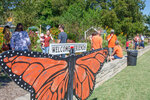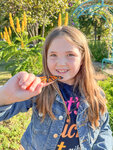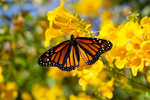


There is nothing quite like Texas when the weather cools just a bit and the entire state breathes a collective sigh of relief that the hottest days are behind us. Something else magical happens in the part of Texas that Hood County inhabits, the migration of the eastern monarch butterfly travels across the county.
Monarch butterflies are unusual in that they migrate. The eastern monarch butterfly exclusively winters in a specific region in Mexico.
The eastern monarch travels through Texas to get to the mountains of Michoacan, Mexico. An area less than 6 acres is all that remains of the land where the monarch winters. Though there are laws now in place to protect the area from logging, poaching remains. Once the butterflies arrive, they go through a period that is similar to hibernating called diapause. This state allows the monarch to wait until the temperature is above 50 degrees in the spring when they will become active again and reproduce.
Hood County is fortunate to be in the smaller part of the visual “funnel” when looking on the map of the eastern monarch migration path. As the monarch travels to overwinter in Mexico, sightings increase.
Though the chances of seeing a monarch in Hood County increases this time of year, the number of monarchs has been decreasing for some time according to enthusiasts. In 2022, the Monarch appeared on the red list of the International Union for Conservation of Nature (IUCN).
 There is a flurry of activity among local conservationists to prepare for the migration, and for the programs that they bring to not only enlighten the public, but also to enlist help in conservation efforts.
There is a flurry of activity among local conservationists to prepare for the migration, and for the programs that they bring to not only enlighten the public, but also to enlist help in conservation efforts.
Both the Rio Brazos Chapter of the Texas Master Naturalists and the Hood County Master Gardeners are presenting programs in October that are free to the public. Both programs are designed to both educate and entertain all ages.
Hood County Master Gardeners invites the public to help make Granbury the “Monarch Capital of Texas” with their “Romancing the Monarch: A Butterfly Festival” on Saturday, Oct. 7 from 1:30 p.m. to 4:00 p.m. at the groups Demonstration Garden at 1410 W. Pearl St. behind Hood County Annex 1, Granbury. If the event is rained, the alternative date is Sunday, Oct. 8 at the same time.
The “Romancing the Monarch” program highlights include learning how to create a butterfly garden, learning the how and why they “tag” monarchs as they head through Hood County, tours of the Demonstration Garden, face painting and crafts, as well as photo opportunities and more. Attendees are encouraged to come early and register to release a monarch butterfly, and to dress like a butterfly.
The Lake Granbury Master Gardeners also sponsored an art contest for local elementary aged students in the weeks leading up to the “Romancing the Monarch” event. Children were given the opportunity to either color and or decorate a template provided or create their own colorful species. The winners of the contest will be announced during the “Romancing the Monarch” event and all the students’ work will be displayed.
First – Second & Third place overall Winners, will be announced during Romancing the Monarch Butterfly Festival on October 7, 2023. Winning art in all schools and grade levels will be on full display at the festival.
Sheri Jones who attended with family last year shared, “The volunteers with the Master Garden center in Granbury put on an impressive event in early fall. Releasing butterflies is a fun time for the entire family!”
The Rio Brazos Chapter of the Texas Master Naturalists will be presenting their monarch event on Saturday, Oct. 21 from 10 a.m. to 2 p.m. at Acton Nature Center, 6900 Smoky Hill Ct. Granbury.
Besides monarch tagging, The Texas Master Naturalists will have various stations offering the life cycle of the monarch, creating a monarch habitat or waystation, paint a “puddler” (a device to provide water to both butterflies and plants), and a station on the Monarch Watch hosted by special guest Carol Clark, considered the “Queen of the Monarch” and more.
Valerie Taber, a chapter member of Rio Brazos Chapter of the Texas Master Naturalist and an organizer for the event in Acton shares that it’s a benefit to the community to have two events. “Both groups have the same goal in mind – the conservation of the monarch butterfly. We just each have a different outlook. Having two events gives the public a better chance of seeing the monarchs in the habitat as we don’t know exactly when they will be passing through. We did start seeing some monarchs around Sept. 12 and 13.”

“The point of the tagging is to be able to see where the monarch came from before getting to Mexico. I believe that three Acton monarchs have been found,” said Taber.
Key information at the events includes how to create a waystation. These are places along the monarch’s path that provide a place for monarchs to refuel, as migration takes a lot of energy. Milkweeds are needed when the monarch travels back up from Mexico in the spring, as the monarch only lay their eggs on the milkweed plant.
Milkweed not only provides food for the caterpillar, but the substance in milkweed also makes the caterpillar and monarch butterfly poisonous to mammals if eaten, causing the animal to be ill. Pesticides and genetically modified crops have substantially reduced the amount of milkweed available to the monarch, making it more critical to provide the plant and other chemical free plants.
“The GMO’s the destruction of their habitat. This is why creating a monarch habitat is so critical. It can be as simple as a single potted plant or a handful of sunflowers, any native plant you can grow in your yard,” offers Taber.
Sara Paulsen, also a chapter member of the Rio Brazos Chapter of the Texas Master Naturalists, fell in love with the monarch in her decades teaching special needs children. “I used the monarch to help teach language and sequencing. I started bringing eggs in, I let the children see the lifespan. I have been doing this for 35 years now. I just love them. I want everyone to learn about the monarch and learn how to preserve their habitat.” Paulsen created an alter-ego named Monica Monarch, a persona Paulsen developed a few years ago in order to teach school children about the Monarch through the eyes of the butterfly.
Citizens can be part of research as well. “There is a lot of science for participants of all ages. We educate the public about citizen science. They can be citizen scientists as well. They can track the monarch and submit their research to different organizations. It expands the knowledge of the scientific community, and their research will be included in the scientific journals,” shares Taber.
For more information on monarchs, attend one of the local monarch events and additionally see monarchwatch.org, journeynorth.org/monarchs